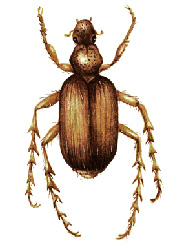Rose chafer, often called the rose bug, is a beetle about 1/3 inch (8 millimeters) long. It is light brown, and has long, spiny legs. It feeds on many plants and is often found on roses, ornamental plants, grapes, and various fruit trees. The beetles eat the blossoms of grapes and roses, and often apples. They also attack many fruits. The rose chafer is particularly destructive in localities where there are large areas of grassland. It lives throughout the eastern and central regions of the United States.

After feeding for three or four weeks, the beetles disappear. The females deposit their eggs in the soil. These eggs hatch, and the larvae feed upon the roots of grass. Nearly full grown by fall, they go below the frost line for the winter. The larva, which looks like a white grub, comes near the surface in the spring and becomes a pupa. There is only one generation each year.
When the beetles are very numerous, the best means of preventing injury is to cover small plants with cloth, or to pick the beetles off by hand. Large numbers can be collected in a pan containing water and kerosene. Commercial plantings of grapes, apples, and other fruit may be protected by cultivating all nearby areas during May and June to destroy any eggs that may have been laid. Insecticides may also be used on the plants.
